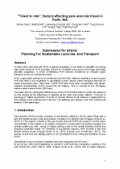-
Past ETC Papers

Browse, search and view papers from the past AET Conferences.
-
Members' Area

AET promotes networking and exchange of ideas, information and opportunities amongst members.
Conference Papers 2013
Frankfurt, Germany
ETC Conference Papers 2013
“Ticket to ride”: factors affecting park-and-ride travel in Perth, WA
Seminar
Day 2 (1 Oct 2013), Session 4, Land Use and Transport, 19:00 - 22:00
Status
Accepted, documents submitted
Submitted by / Abstract owner
Doina Olaru
Authors
Doina Olaru, UWA, Brett, Smith, Cecilia Xia, Curtin University
Short abstract
Interest in the use of park-and-ride (PnR) has surged in recent years. Seen as an attractive alternative that combines the efficiency of mass transit systems with the flexibility of the car, PnR provides residents of low-density suburbs with a fast and flexible access mode and reduces congestion on arterial roads. In Perth, there are more than 17,500 PnR bays at 55 (out of 70) railway stations, along five rail lines. Their majority is built at the newly constructed stations along the north-south spine of the city.
Based on a detailed audit of PnR facilities at all stations, this paper identified the key differentiating factors of access and service across rail corridors and tested their influence on patronage. Four uni-dimensional constructs: parking supply (free and secure, locked & paid parking), facilities within the station perimeter (public utilities, bike lockers, disabilities access, retail and food, etc.), land use mix around the railway station, and distance/time accessibility by motorised and non-motorised modes, were significantly different across the corridors. Then, when compared with the patronage level, car accessibility and the parking supply were most influential in determining the number of daily boardings, more so than collocating activities or public transport hubs.
Abstract
1. Objective
“Transport oriented development” (TOD) or “smart growth” aims to limit urban sprawl by collocating residential and activity centres at key transport nodes. However, in low-density cities such as Perth, Western Australia, park-and-ride (PnR) is gaining popularity as a means to increase the public transport ridership. The new stations along the north-south spine of the city are spaced five times further than the traditional lines and have as many as 1,000 parking bays. Yet, one in three of these new stations are positioned in fledgling TOD centres. This paper aims to identify the key differentiating factors of access and service and to test their influence on patronage.
2. Data/Methodology
A detailed audit of park-and-ride features using over 30 measures of services, facilities and accessibility is conducted for 70 stations on five railway corridors. Confirmatory factor analysis identified four uni-dimensional constructs: parking supply (free and secure, locked & paid parking), facilities within the station perimeter (public utilities, bike lockers, disabilities access, retail and food, etc.), land use mix around the railway station and distance/time accessibility by motorised and non-motorised modes. A cluster analysis indicates that the station’s characteristics are mostly dependent on which line the station is on. This appears to be a function of the period in which the station was built. The number of daily boardings is then compared across the level of station characteristics.
3. Results/Findings
Car accessibility and the parking supply are the most influential factors in determining the level of ridership through park-and-ride. However, walking and cycling accessibility measures are associated with higher patronage. The new stations are situated in less diverse land-use mix locations but have the highest level of patronage, indicating that availability of parking is the driver of train ridership, more so than collocating activities and public transport hubs. The results are less conclusive on the impact of feeder bus access.
4. Implications for Research/Policy
The review clearly indicates that the provision of PnR facilities at stations is the most significant driver of rail patronage in a low-density city like Perth. The provision of activity centres at rail stations tends to limit car access to the station and reduces the “affective catchment” of the station. This opens the debate on what it is planners are aiming to achieve, high levels of patronage or active and vibrant centres. Pursuits of these goals lead to very dissimilar station precinct designs.
Documents:

Association For
European Transport
Forester House
Doctors Lane
Henley-in-Arden
Warwickshire, UK
B95 5AW
+44 (0) 15 64 793552
VAT number: 710 1866 64
Conference Supporters & Endorsers




Legal Entity
The Association for European Transport is registered as an Association ('vereniging') with the Chamber of Commerce for Haaglanden in The Netherlands under company number 27170096.
Built on Zenario




